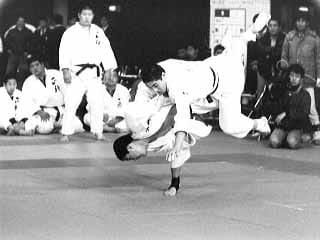You may be clever, But it is better to make use of circumstance; You may have a hoe, But it is better to wait for the right season. -- Mencius

![]()
![]() During Judo contest try to think of nothing at all. Be as a tranquil pool of water in the woods. Calm, collected, reflecting on its surface all that is around it. Make your own mind such a quiet mirror reflecting the mind of the opponent. Even as your partner’s impulse to attack passes through his mind it should be reflected in you. The result is that a defense starts at the same time as, or before, the opponent’s offense.
During Judo contest try to think of nothing at all. Be as a tranquil pool of water in the woods. Calm, collected, reflecting on its surface all that is around it. Make your own mind such a quiet mirror reflecting the mind of the opponent. Even as your partner’s impulse to attack passes through his mind it should be reflected in you. The result is that a defense starts at the same time as, or before, the opponent’s offense.
Kano recognized three levels of combative initiative (sen): 1) go no sen, the “late” form of attack initiative, usually characterized as a defensive move or counteraction; 2) sen, the attack initiative that is also defensive but launched simultaneously with the aggressor’s attack; 3) sen-sen no sen, a supraliminal attack initiative, also defensive but appearing to be offensive, through which the aggressor’s attack is anticipated and “beaten to the punch” by an appropriate action.
A judoka who can execute his techniques with all three forms of attack initiative is a master technician. Judo that contains all three kinds of initiative is a tremendously flexible art, and is therefore applicable to any attack-defense situation.
—Judo Formal Techniques, Tadao Otaki and Donn Draeger

![]()
![]() The primary thing when you take a sword in your hands is your intention to cut the enemy, whatever the means. Whenever you parry, hit, spring, strike, or touch the enemy’s sword, you must cut the enemy in the same movement. It is essential to attain this. If you think only of hitting, springing, striking, or touching the enemy, you will not be able to cut him. More than anything, you must be thinking of carrying your movement through to cutting him. You must thoroughly research this. –Miyamoto Musashi
The primary thing when you take a sword in your hands is your intention to cut the enemy, whatever the means. Whenever you parry, hit, spring, strike, or touch the enemy’s sword, you must cut the enemy in the same movement. It is essential to attain this. If you think only of hitting, springing, striking, or touching the enemy, you will not be able to cut him. More than anything, you must be thinking of carrying your movement through to cutting him. You must thoroughly research this. –Miyamoto Musashi

![]()
![]() In order to achieve victory you must place yourself in your opponent’s skin. If you don’t understand yourself, you will lose one hundred percent of the time. If you understand yourself, you will win fifty percent of the time. If you understand yourself and your opponent, you will win one hundred percent of the time. — Tsutomu Oshima
In order to achieve victory you must place yourself in your opponent’s skin. If you don’t understand yourself, you will lose one hundred percent of the time. If you understand yourself, you will win fifty percent of the time. If you understand yourself and your opponent, you will win one hundred percent of the time. — Tsutomu Oshima

Defensive Tactics
In defensive tactics it is not a matter of matching your strength and power against the strength and power of your opponent but, rather, the direction of all your strength and power toward your opponent’s weakness. —Defensive Tactics FBI Training Manual
In the tussles that take place in the inner-city streets and on the subways or in close quarters … you rarely have an opportunity to get off a full square punch or any kind of kick. When people are jumping on you, choking you, grabbing and tussling, just the use of your body and the movement of the opponent or opponents — letting their body weight and their movement and the physics of it all — take you away. Just spinning and tossing people aside, and then falling, which is the key thing. Because any fighter who’s fought any number of battles ends up on the ground more often than he or she wants to admit. — Curtis Sliwa, Founder and Director of the Guardian Angels
Avoid conflict, seek harmony. The safest battle is the one that is never fought. Knowledge is power. The more you know about your enemy the stronger your position. Mental victory leads to physical victory. The mental battle begins before the physical battle. If you can defeat your opponent mentally half of the battle is won. If conflict is inevitable enter it with total resolve. Do not do things half way.

A Zen master out for a walk with one of his students pointed out a fox chasing a rabbit. “According to an ancient fable, the rabbit will get away from the fox,” the master said.
“Not so,” replied the student. “The fox is faster.”
“But the rabbit will elude him,” insisted the master.
“Why are you so certain?” asked the student.
“Because the fox is running for his dinner and the rabbit is running for his life,” answered the master.
It isn’t the size of the dog in the fight, |
